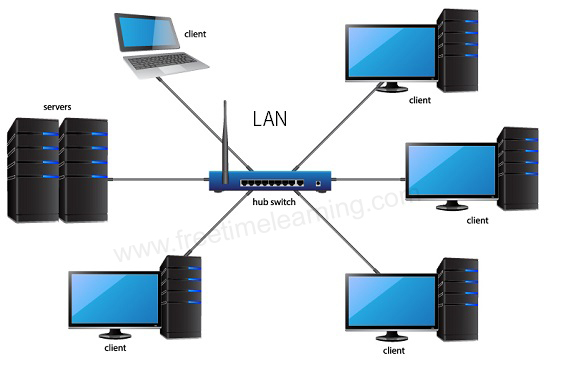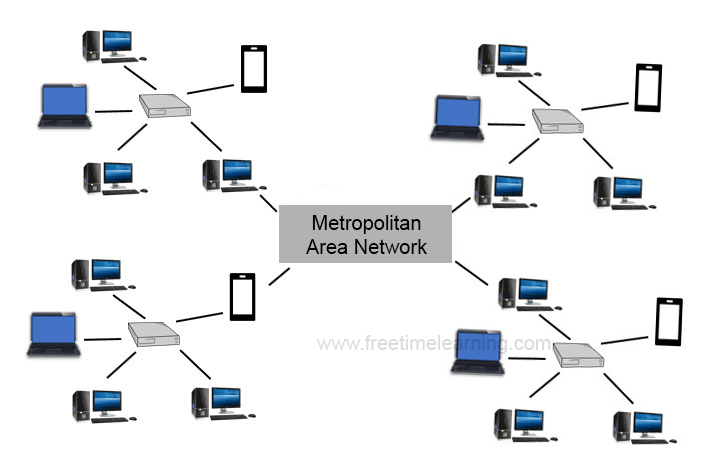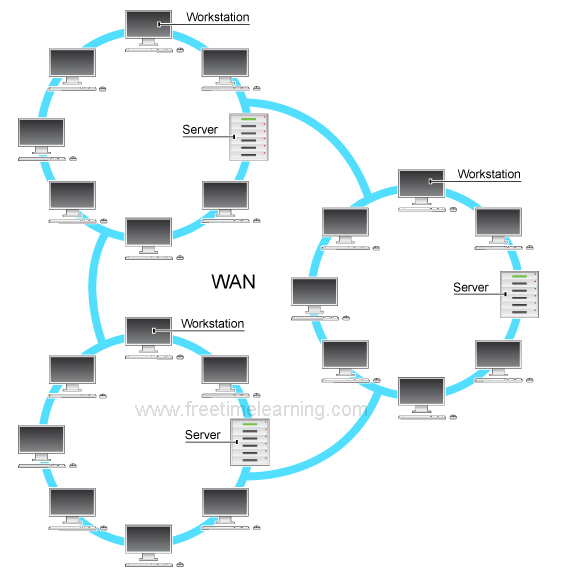
A Local Area Network (LAN) is a group of computer and peripheral devices which are connected in a limited area such as school, laboratory, home, and office building. It is a widely useful network for sharing resources like files, printers, games, and other application.

It is less costly as it is built with inexpensive hardware such as hubs, network adapters, and ethernet cables. The data is transferred at an extremely faster rate in Local Area Network. Local Area Network provides higher security.
A metropolitan area network is a network that covers a larger geographic area by interconnecting a different LAN to form a larger network.
Government agencies use MAN to connect to the citizens and private industries. It has a higher range than Local Area Network(LAN).
In MAN, various LANs are connected to each other through a telephone exchange line.
The most widely used protocols in MAN are RS-232, Frame Relay, ATM, ISDN, OC-3, ADSL, etc.

Wide Area Network or simply WAN is a system of network that covers a large geographical area across the world.
The services of WAN are provided by public (government) agencies as well as private agencies. The network also provides the facility to access databases located remotely.
The WAN system is highly beneficial for MNCs and other big corporate companies (offering online services).

PAN is a computer network formed around a person. It generally consists of a computer, mobile, or personal digital assistant. PAN can be used for establishing communication among these personal devices for connecting to a digital network and the internet.
Advantages of PAN :
PAN networks are relatively secure and safe.
It offers only short-range solution up to ten meters
Strictly restricted to a small area
WLAN (Wireless Local Area Network)
SAN (Storage Area Network)
System Area Network
Home Area Network
POLAN- Passive Optical LAN
Enterprise private network
CAN (Campus Area Network)
VPN (Virtual Area Network)
WLAN (Wireless Local Area Network) : WLAN (Wireless Local Area Network) helps you to link single or multiple devices using wireless communication within a limited area like home, school, or office building. It gives users an ability to move around within a local coverage area which may be connected to the network. Today most modern day's WLAN systems are based on IEEE 802.11 standards.
SAN (Storage-Area Network) : A Storage Area Network is a type of network which allows consolidated, block-level data storage. It is mainly used to make storage devices, like disk arrays, optical jukeboxes, and tape libraries.
System-Area Network : System Area Network is used for a local network. It offers high-speed connection in server-to-server and processor-to-processor applications. The computers connected on a SAN network operate as a single system at quite high speed.
Home Area Network : A Home Area Network is always built using two or more interconnected computers to form a local area network (LAN) within the home. This type of network helps computer owners to interconnect with multiple computers.
POLAN- Passive Optical LAN : POLAN is a networking technology which helps you to integrate into structured cabling. It allows you to resolve the issues of supporting Ethernet protocols and network apps.
Enterprise private network : Enterprise private network (EPN) networks are build and owned by businesses that want to securely connect numerous locations in order to share various computer resources.
CAN (Campus Area Network) : A Campus Area Network is made up of an interconnection of LANs within a specific geographical area. For example, a university campus can be linked with a variety of campus buildings to connect all the academic departments.
VPN (Virtual Private Network) : The VPN network uses "virtual" connections routed through the internet from the enterprise's private network or a third-party VPN service to the remote site.